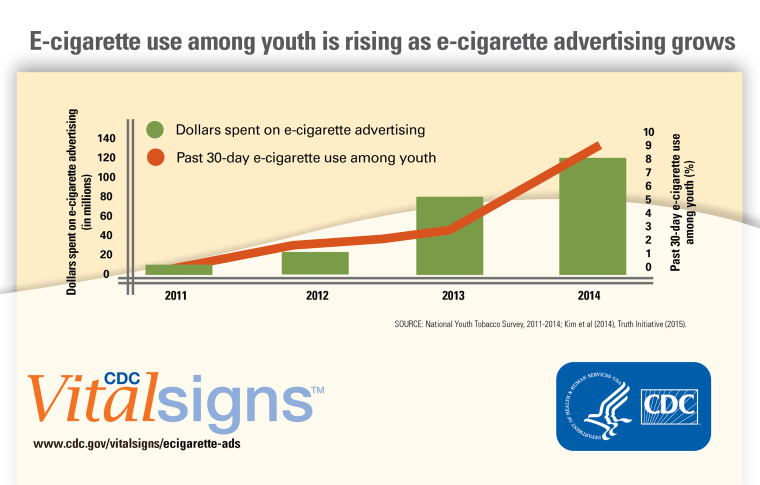E-cigarette makers are pouring tens of millions of dollars into advertising their wares — and teenagers are getting the message loud and clear, federal health officials reported Tuesday.
As advertising skyrockets, so do the number of teens seeing it. They’re vaping by the millions now, the Centers for Disease Control and Prevention reports. The CDC says that trend threatens to derail decades of progress in helping prevent kids from taking up smoking.

“The same advertising tactics the tobacco industry used years ago to get kids addicted to nicotine are now being used to entice a new generation of young people to use e-cigarettes,” said CDC director Dr. Tom Frieden.
Inside the Vaper's Den: E-Cigarette Salvation and New Dangers
“What’s happening is widespread marketing of e-cigarettes that kids are seeing,” Frieden told reporters in a telephone briefing.
“It shouldn’t be a surprise that youth use of e-cigarettes has skyrocketed when kids are being inundated with marketing for these products.”
“Kids should not be using e-cigarettes and yet 2/3 of kids in this country are seeing e-cigarette ads.”
CDC researchers used a 2014 survey of 22,000 children and teens to find that 68.9 percent of middle and high school students — more than 18 million kids — see e-cigarette ads. More than half see them advertised in stores, 40 percent online and 36 percent on TV or in movies.
“During 2011 to 2014, current e-cigarette use among high school students soared from 1.5 percent to 13.4 percent, and among middle school students from 0.6 percent to 3.9 percent,” the CDC said in a statement. "At the same time, spending on e-cigarette ads rose from $6.4 million to $115 million.”

Advocates said the industry must be stopped from advertising to children.
“The irresponsible and indiscriminate marketing by the e-cigarette industry, coupled with a complete lack of government oversight, is putting the health of our nation’s kids at risk,” said Matthew Myers, president of the Campaign for Tobacco-Free Kids.
“It shouldn’t be a surprise that youth use of e-cigarettes has skyrocketed when kids are being inundated with marketing for these products.”
Frieden said the tactics are effective, and include online “viral” marketing that cannot even be measured.
“E-cigarette ads use many of the same themes — independence, rebellion, and sex — used to sell cigarettes and other conventional tobacco products,” the CDC report said.
There’s also a widespread belief that e-cigarettes are safe, or at least safer than conventional tobacco products. But several studies have suggested this may not be the case.
“E-cigarettes typically deliver nicotine derived from tobacco, which is highly addictive, might harm brain development, and could lead to sustained tobacco product use among youths,” the CDC said.
Late last year a team at the Harvard School of Public Health found many e-cigarette flavors deliver harmful chemicals, including diacetyl, the chemical blamed for causing "popcorn lung" in workers at microwave popcorn packaging plants. Other teams found formaldehyde, which is known to cause cancer.
The U.S. Food and Drug Administration in 2014 proposed asserting its authority over new tobacco products including e-cigarettes, cigars, pipe tobacco and nicotine gels. The White House is reviewing final proposed regulations for it to do that.
Supporters and some researchers say e-cigarettes may help people quit smoking what they call combustible cigarettes, but the research is limited.
Public health experts have been clamoring for FDA to extend its authority as e-cigarettes have exploded in popularity. Former FDA commissioner Dr. Margaret Hamburg called the industry the “wild, wild West.”
The American Cancer Society's Cancer Action Network and the American Lung Association both urged the White House to speed authority for FDA to regulate e-cigarettes.
"Once the FDA has authority, the American Lung Association urges it to act swiftly to crack down and end marketing practices aimed at youth," the group said in a statement.
"It is also incumbent on states to enact and enforce laws to stop retailers from selling these products to children."
CDC says studies have shown that tobacco ads work. “Tobacco product advertising can entice youth to start using tobacco,” the report says.
And limits on that advertising, as well as taxes, restrictions on retail sales, ads promoting tobacco abstinence and other measures have been shown to work.
But states are not using money they were awarded from tobacco companies to fight tobacco use, the CDC said.
“However, in 2015, states appropriated only 1.9 percent ($490.4 million) of combined revenues of $25.6 billion from settlement payments and tobacco taxes for all states on comprehensive tobacco control programs, representing less than 15 percent of the CDC-recommended level of funding ($3.3 billion) for all states combined,” it said.
“Only two states (Alaska and North Dakota) currently fund tobacco control programs at CDC-recommended levels.”
